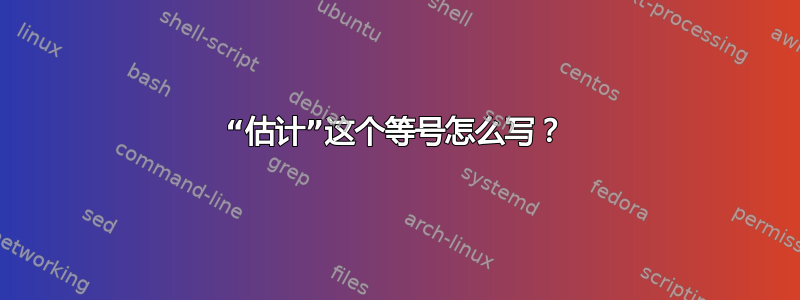
我正在寻找一个代码,它可以描述估计等号,如下所示http://en.wikipedia.org/wiki/Equals_sign#Other_related_symbols(第六个标志:估计)。
答案1
下面总结了估计符号的许多变体,而不改变全部数学符号。
\newcommand*{\estimatesA}{\mathrel{\hat=}}
\newcommand*{\estimatesB}{\mathrel{\widehat=}}
\newcommand*{\estimatesC}{\stackrel{\scriptscriptstyle\wedge}{=}}
来源:Dante常见问题\displaystyle备注:仅 推荐用于\textstyle较小的款式,否则\wedge会显得太大。
\newcommand*{\estimatesD}{\hateq} % MnSymbol
资料来源:Jukka K. Korpela回答
\newcommand*{\estimatesE}{\corresponds} % mathabx
\newcommand*{\estimatesF}{\mathrel{\text{\Corresponds}}} % marvosym
资料来源:Ian Thompson评论
\documentclass{article}
\newcommand*{\estimatesA}{\mathrel{\hat=}}
\newcommand*{\estimatesB}{\mathrel{\widehat=}}
\newcommand*{\estimatesC}{\stackrel{\scriptscriptstyle\wedge}{=}}
\newcommand*{\estimatesD}{\hateq} % MnSymbol
\newcommand*{\estimatesE}{\corresponds} % mathabx
\newcommand*{\estimatesF}{\mathrel{\text{\Corresponds}}} % marvosym
\usepackage{marvosym,amstext}
\makeatletter
% \hateq from MnSymbol
% \usepackage{MnSymbol}
\@ifpackageloaded{MnSymbol}\@tempswafalse\@tempswatrue
\if@tempswa
\DeclareFontFamily{U}{MnSymbolD}{}%
\DeclareSymbolFont{MnSyD}{U}{MnSymbolD}{m}{n}%
\SetSymbolFont{MnSyD}{bold}{U}{MnSymbolD}{b}{n}%
\DeclareFontShape{U}{MnSymbolD}{m}{n}{
<-6> MnSymbolD5
<6-7> MnSymbolD6
<7-8> MnSymbolD7
<8-9> MnSymbolD8
<9-10> MnSymbolD9
<10-12> MnSymbolD10
<12-> MnSymbolD12}{}%
\DeclareFontShape{U}{MnSymbolD}{b}{n}{
<-6> MnSymbolD-Bold5
<6-7> MnSymbolD-Bold6
<7-8> MnSymbolD-Bold7
<8-9> MnSymbolD-Bold8
<9-10> MnSymbolD-Bold9
<10-12> MnSymbolD-Bold10
<12-> MnSymbolD-Bold12}{}%
\DeclareMathSymbol{\hateq}{\mathrel}{MnSyD}{61}%
\fi
% \corresponds from mathabx
% \usepackage{mathabx}
\@ifpackageloaded{mathabx}\@tempswafalse\@tempswatrue
\if@tempswa
\DeclareFontFamily{U}{mathb}{\hyphenchar\font45}%
\DeclareFontShape{U}{mathb}{m}{n}{
<5> <6> <7> <8> <9> <10> gen * mathb
<10.95> mathb10 <12> <14.4> <17.28> <20.74> <24.88> mathb12
}{}%
\DeclareSymbolFont{mathb}{U}{mathb}{m}{n}%
\DeclareFontSubstitution{U}{mathb}{m}{n}%
\DeclareMathSymbol{\corresponds}{\mathrel}{mathb}{"1D}%
\fi
\makeatother
\begin{document}
\[
A \estimatesA
B \estimatesB
C \estimatesC
D \estimatesD
E \estimatesE
F \estimatesF
G
\]
\end{document}
OpenType 字体
LuaTeX 和 XeTeX 支持 OpenType 字体。该软件包unicode-math支持 OpenType 数学字体。符号 ≙ 可以以不同的方式使用:
- 直接输入Unicode符号:
≙ - 该符号的 ASCII 表示法:
^^^^2259 - 命令名称(包
unicode-math):\wedgeq
以下示例显示了三种 OpenType 数学字体(系列名称/PostScript 名称/字体名称)中的符号:
- 拉丁现代数学/LatinModernMath-Regular/
latinmodern-math.otf - Asana Math/Asana-Math/
Asana-Math.otf - XITS 数学/XITSMath/
xits-math.otf
\documentclass{article}
\usepackage{unicode-math}
\AtBeginDocument{%
\setmathfont{latinmodern-math.otf}%
\newsavebox\BoxG\sbox\BoxG{$\wedgeq$}%
%
\setmathfont{Asana-Math.otf}%
\newsavebox\BoxH\sbox\BoxH{$\wedgeq$}%
%
\setmathfont{xits-math.otf}%
\newsavebox\BoxI\sbox\BoxI{$\wedgeq$}%
%
\setmathfont{latinmodern-math.otf}%
}
\newcommand*{\test}[1]{\mathrel{\copy#1}}
\begin{document}
\[
G \test\BoxG
H \test\BoxH
I \test\BoxI
J
\]
\end{document}
答案2
只需使用\mathrel{\hat{=}}。或者\widehat如果您愿意,也可以使用 。更准确地说:
\documentclass[12pt, a4paper]{article}
\usepackage{amsmath}%
\newcommand*\estimates{\mathrel{\hat{=}}}
\newcommand*\wideestimates{\mathrel{\widehat{=}}}
\begin{document}
\begin{align*}
& A \estimates B \\
& A \wideestimates B \\
& A = B
\end{align*}
\end{document}

答案3
您可以\hateq从mnsymbol包中使用:
\documentclass{article}
\usepackage{mnsymbol}
\begin{document}
$$a \hateq b$$
\end{document}
另一种方法是使用\correspondsfrom mathabx,但它看起来不太正确。
答案4
有一个乳胶符号表示这个:$\triangleq$




